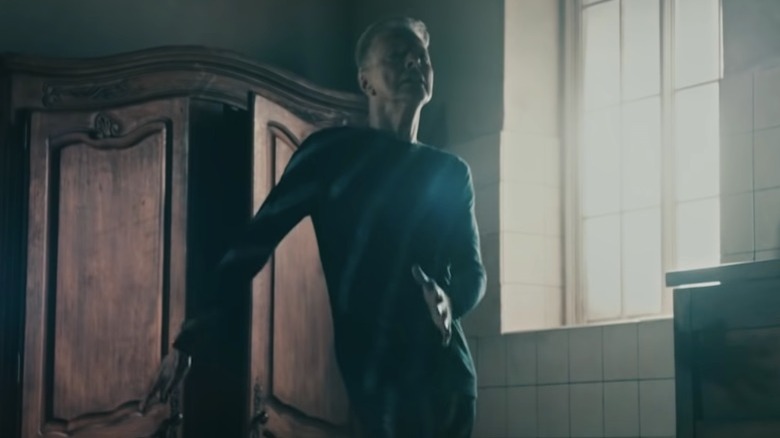The Tragic Story Behind David Bowie's Last Single, Lazarus
Who was the real David Bowie? To legions of fans, Bowie — who was born David Jones, only changing his stage name to avoid being confused by Davy Jones of The Monkees — was a musical colossus, who over the course of a pop career lasting over half a century achieved astonishing worldwide critical and commercial success through a bevy of chameleon-like transformations and stylistic segues.
To those who worked with him, such as the comedian Ricky Gervais (via Smooth Radio), he was above all a man of humor, who didn't, according to Gervais, take himself too seriously. "Sometimes I forgot that he was David Bowie, because he was a friend, and he was David Jones, and a normal bloke ... I think people think he sits around in a silver suit with his orange hair," like his most famous character, Ziggy Stardust. "He's just a guy who was brilliant at what he did, and he never stopped — he never stopped creating. He never let me down."
But whether friend or fan, no one was quite prepared for the magic that Bowie would conjure with his final studio project, "Blackstar," which, along with its second single, "Lazarus," turned out to be a breathtaking artistic spectacle as well as a devastating personal insight into human fragility and, ultimately, strength in the face of mortality.
Bowie's unexpected comeback
When David Bowie's "Blackstar" was first announced, it appeared to mark a continuation of the musician's unexpected comeback. For most of the 2000s, Bowie had been away from the music business. In 2004, he was touring two well-received studio albums around the world as part of the "Reality Tour," but was forced to cancel 14 dates after having emergency surgery on a blocked artery while performing in Germany in June.
From then on, Bowie turned his back on the music business, and for many years was assumed to have retired, until the release of the mournful single "Where Are We Now?" on his 66th birthday on January 8, 2013, marking his unexpected return. The single was followed in March by "The Next Day," his first album of new material in almost a decade. The album was followed in turn by the 2014 compilation "Nothing has Changed," which included new material and suggested Bowie was experiencing a creative revival.
In 2015, Rolling Stone ran a feature on "Blackstar," stylized ★, and the jazz musicians he had recruited out of the blue to collaborate on it. "It did surprise me," said drummer Mark Guiliana. "But I feel like he's built a career and artistic identity on surprises. It falls in line with who he is as an artist."
Working through sickness
Outlets such as Rolling Stone suggested that Bowie's aversion to the limelight was evidence that rumors of ill health — which had circulated since his 2004 heart attack — carried some weight. However, Bowie's producer Tony Visconti publicly denied his collaborator and friend was in any way ill. "He's in fine health ... He's just made a very rigorous album," Visconti told Rolling Stone in November 2015.
Sadly, unknown to the majority of David Bowie's friends and collaborators at the time, the musician was also coping with liver cancer, which had first been diagnosed in 2014, per The New Zealand Herald. According to a close friend, the singer kept his illness a secret while he underwent over a year of treatment.
Filmmaker Johan Renck was the director on the music video for "Lazarus," and recalls the tragic timing of the October 2015 filming. "David said: 'I just want to make it a simple performance video' ... I immediately said 'the song is called "Lazarus," you should be in the bed.'" But little did he know that the video would come to represent the deathbed scene of one of pop music's biggest stars. "To me it had to do with the biblical aspect of it ... it had nothing to do with him being ill. I found out later that, the week we were shooting, it was when he was told it was over, they were ending treatments and that his illness had won" (via The Guardian). The imagery of the video surely took on a deeper meaning for the now terminal-ill singer.
The death of David Bowie
"Lazarus" premiered on BBC Radio 6's Steve Lamacq Show on December 17, 2015, and was widely praised for continuing the adventurous direction his work had taken with the release of the "Blackstar" single the previous month.
The "Blackstar" album was released on Bowie's birthday in 2016 to warm reviews, with The Atlantic praising the work as "mysterious and gorgeous" while admitting its impenetrability, and noting that a dubious comment from one of Bowie's musicians claiming that the title song might in fact be about the ISIS caliphate was the only tidbit fans had to work with. Meanwhile, The Guardian described the record as "urgent, contemporary, and elliptical."
But little did reviewers know at the time was that a huge piece of the puzzle was missing: the circumstances of Bowie's ill health at the time of recording, which cast a new light on his work when his death was announced on January 10, 2016, just two days after the album's release.
Video symbolism
Though director Johan Renck denied that the video for "Lazarus" contains any overt reference to David Bowie's ill health, in the days following Bowie's death fans and critics alike suggested the video was infused with a whole host of symbolic objects and moments which took on intriguing new resonances as a result. Beside the image of Bowie lying in — and then eerily hovering above — what is potentially a hospital bed, and numerous memento mori including a skull sat on Bowie's writing table (via The Guardian), critics have drawn attention to the second outfit Bowie wears: a striped leotard which he dances in before sitting at his table to write.
As Huffington Post highlights, the outfit is a callback to one the singer wore way back in 1974, when posing for photographer Steve Schapiro. At the time, Bowie was exploring mysticism, particularly Kabbalah, and in various shots he can be soon doodling images of the Tree of Life, aspects of which were also explored on his contemporaneous album "Station To Station." By harking back to this moment, Bowie seems to be offering a cryptic meditation on life and death.
"He appears to have found the meaning he has been searching for. The connection between both images, 40 years apart, is stunning ... He has resolved his enigma, and the curtain can fall at last," suggested critic Albin Wantier (via Huffington Post). Notably, the final act that the Kabbalah-outfitted Bowie completes is one of creation: a feverish outpouring of writing, which some have interpreted as a parallel to the final outburst of music making Bowie accomplished before his death.
Who is Lazarus?
Following Bowie's death, many outlets, such as The Independent, posited confidently that the titular character of the song was undoubtedly the Biblical Lazarus of the New Testament, who is resurrected from the grave by Jesus Christ in the Gospel According to John (via Britannica): "This sickness will not end in death ... No, it is for God's glory so that God's Son may be glorified through it. He who believes in me will live, even though he dies," Jesus told the ailing Lazarus, as The Independent notes.
However, one Bowie collaborator has suggested that may not be the whole story. According to writer Michael Cunningham, who was recruited by Bowie to collaborate on a musical back in 2013, Bowie had an interest in the poet Emma Lazarus, and wanted her to feature as a character in the work (via GQ). Lazarus' poem "The New Colossus" — with the famous lines "Give me your tired, your poor,/Your huddled masses yearning to breathe free" — adorns the base of the Statue of Liberty (posted at Poetry Foundation). Taken in light of the lyric "when I first got to New York/I was living like a king," it seems that the name "Lazarus" is, therefore, a dual allusion, suggesting more than Biblical resurrection. As with many Bowie songs, it is difficult to pin down a single fixed meaning; even if "Lazarus" seemed to be the work of an artist laying everything out for his fans, as Bowie tells us on another "Blackstar" track: "I Can't Give Everything Away."



